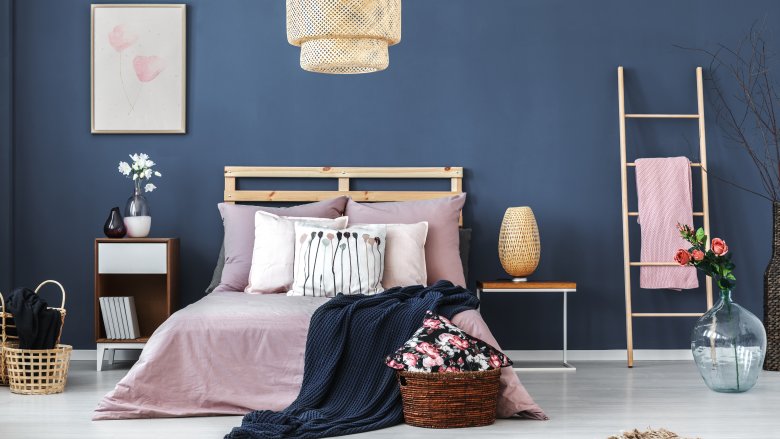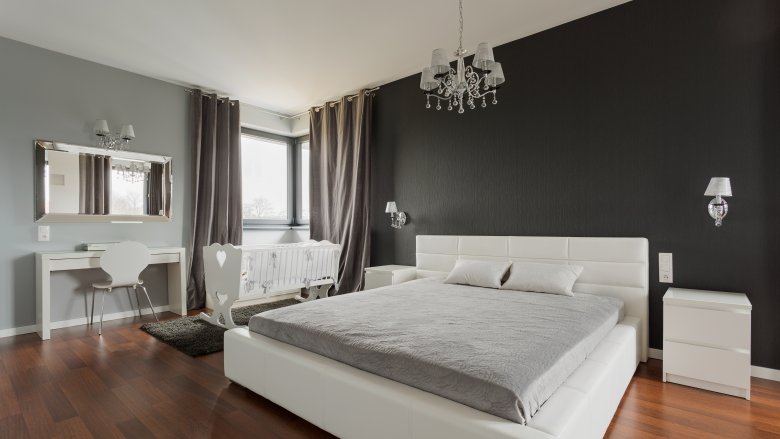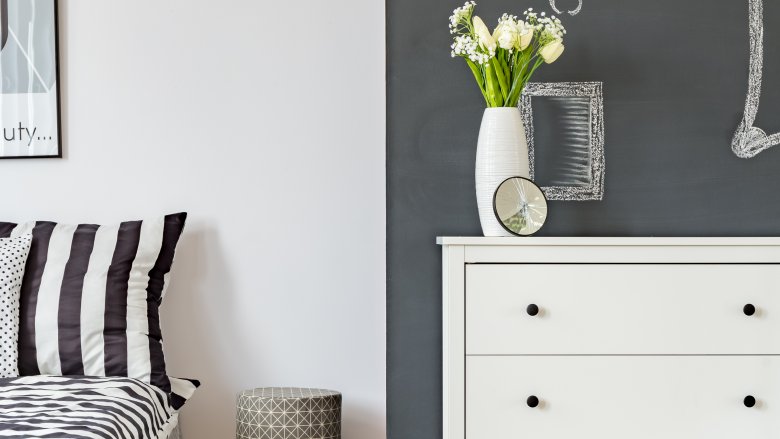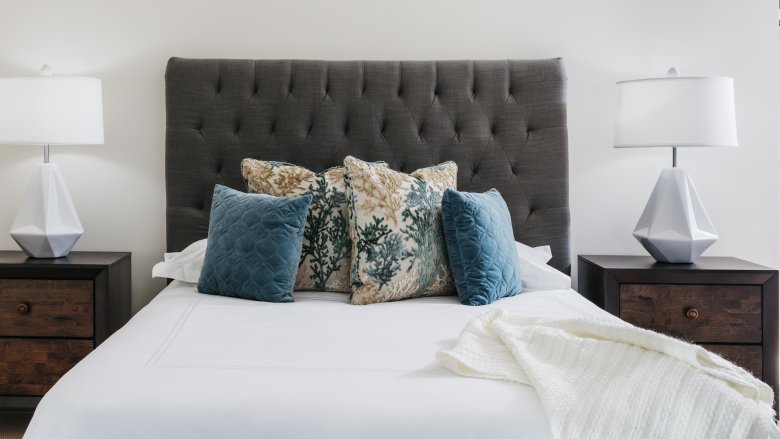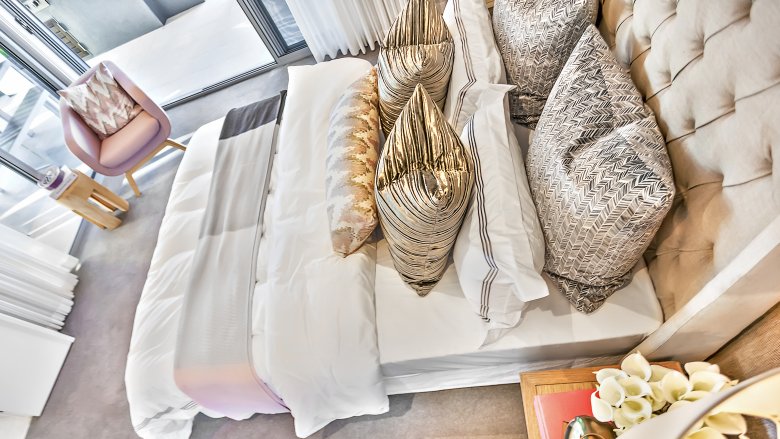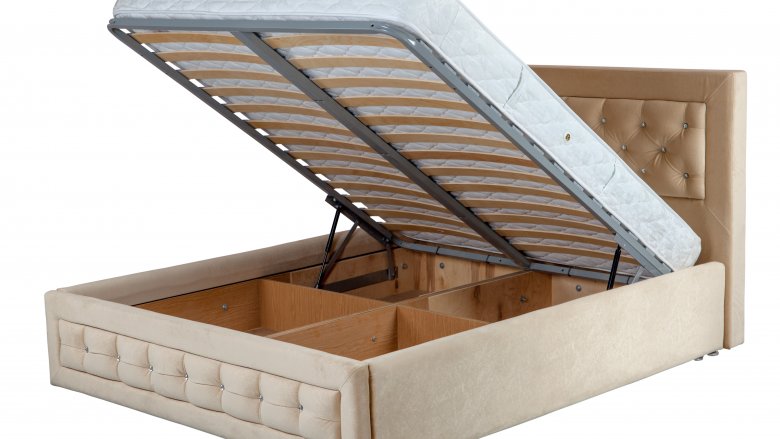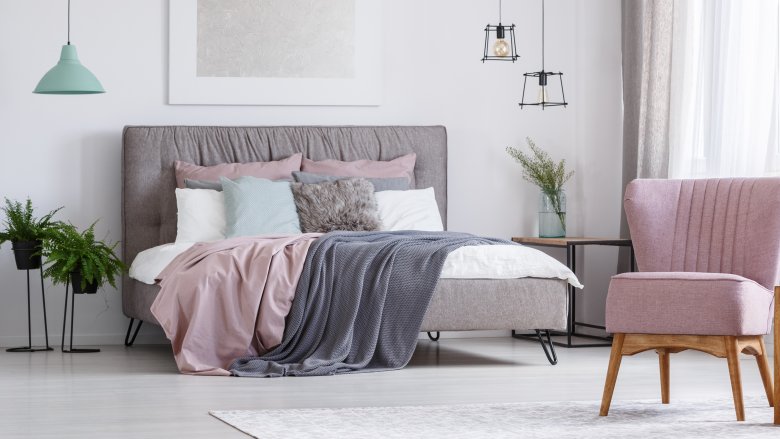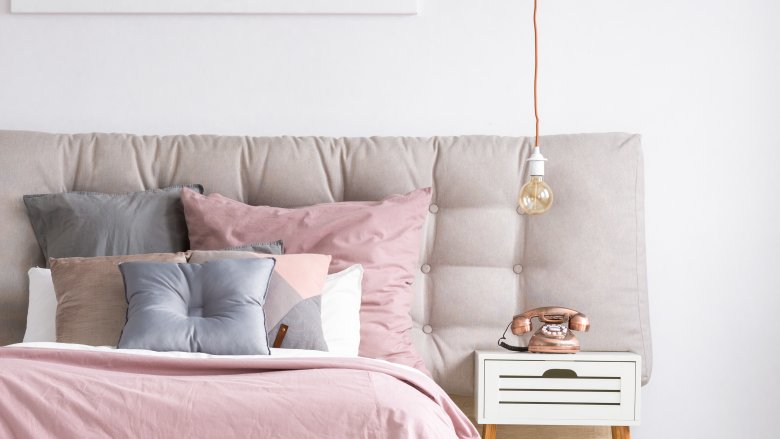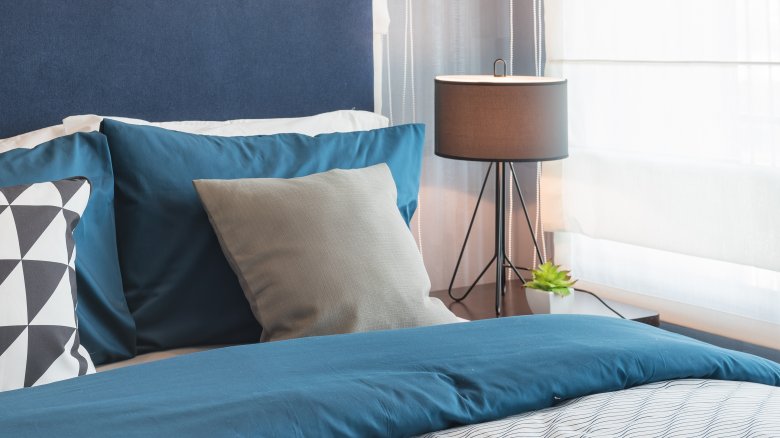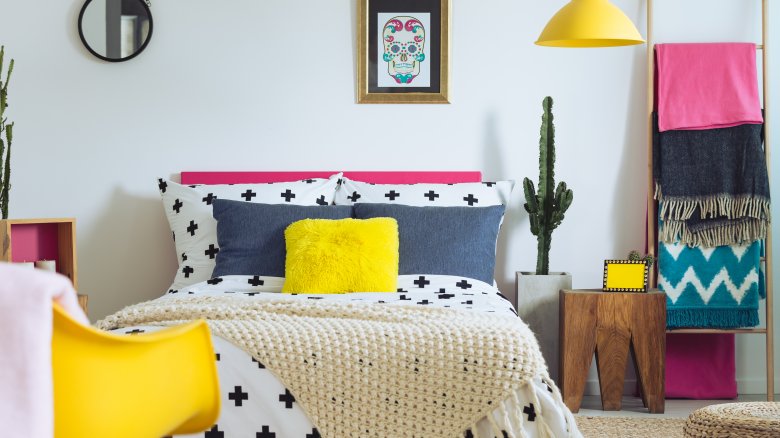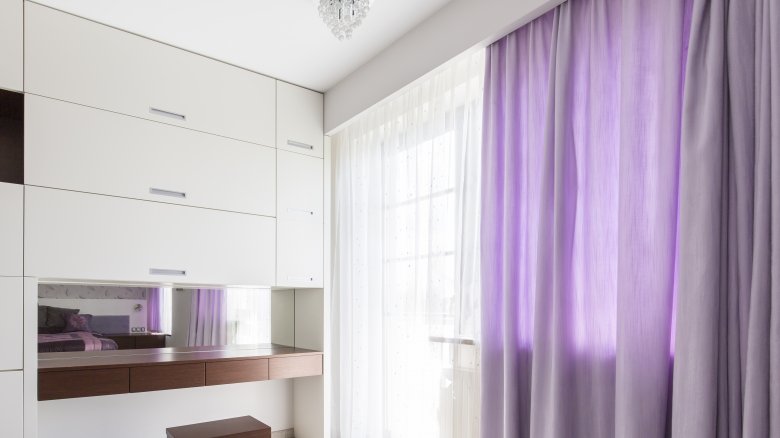Hacks For Arranging Your Bedroom
Rearranging your bedroom can be a fun, but daunting experience. It might make you wonder whether it's worth taking on the project at all. Home is where the heart is, the adage goes — but what if home doesn't feel quite as homey as you'd like? According to all the experts I spoke to, the most important part of any home is the bedroom.
A bedroom is meant to be a space where you can relax, recharge, and let the stresses of the day melt right off your back, but if it feels like just a random space that you happen to sleep in, that pervasive feeling of "meh" can infuse other areas of your life too. So, if the bedroom is that important, what are some hacks for arranging your bedroom so that it feels like a sanctuary?
Focus on the bed
The bed is the most important element of the bedroom, and numerous experts recommend starting with bed placement and then arranging everything else around it. Start by determining the best placement for the bed, notes Becki Owens, a California-based designer interviewed by Apartment Therapy: the best place for the bed is usually the "longest uninterrupted wall." But, that said, sometimes small or a wonky floor plan can make this nearly impossible — so, Owens noted, "Don't be afraid to put your bed up against a window if necessary.... The aim here is to make the bed a focal point of the room."
Additionally, Libby McMillan, editor at Apartment Guide, explained to me that placing beds along the longest uninterrupted wall isn't a hard-and-fast rule. She noted that you can take into consideration questions like whether or not you like to watch TV in bed, since "a cable connection on any wall except the one opposite the bed might irritate you." Basically, feel free to try out different arrangements until you land on one that both works for you and allows you to make the bed the focal point of the room.
Once you've figured out where the bed will be, Liz Toombs, a Kentucky-based interior designer, recommends making a statement wall behind your bed. By creating an accent wall using either bold paint or wallpaper, you'll make the bed the unequivocal focus of the room, and Toombs notes that "the goal is to say 'wow' whenever you walk into the room."
Arrange other furniture after you've placed the bed
After you've found a good location for the bed, the next step is to see where the other furniture will go. Owens, speaking with Apartment Therapy, recommended mapping out the entire bedroom before moving around any other furniture. "You should be able to easily walk around the room, open drawers without any trouble, and not feel cramped," she explained. "A good rule of thumb is to leave at least 22 inches of walking space around either side of the bed and at its foot."
According to Carole Marcotte, an interior designer in Raleigh, North Carolina, if you're in extra-cramped quarters, you can always do away with the dresser. "I try to organize closets to include space for folded clothes, thereby eliminating the need for a dresser," she explained. "One less large piece of furniture in the room really helps."
Another approach is to try out arranging different furniture configurations to see what works best. "You might find that you prefer a fast and easy pathway from the bedroom door to the closet or bathroom," McMillan told me. "Don't be afraid to experiment when deciding where the bedroom furniture goes." Additionally, McMillan recommended waiting to finalize your space until after you've tried different furniture configurations. This will allow you to see what works for that space, and "you might find that you prefer [your bed] on a wall with windows, or in a place that you didn't think of originally." So, feel free to run through different ideas!
Focus on symmetry and lines of sight
"Symmetry is key," Anna Shiwlall, a California-based interior designer, told me. "Giving the space visual balance calms the mind and makes the room much more comfortable and livable." In order to do that, you can use matching bedside tables and lamps on either side of the bed — but if you don't have enough space for two bedside tables, Shiwlall notes that if there's a "window on one side of your bed, you can give the illusion that there's another window by adding a mirror that's the same size on the other side of your bed. It gives great symmetry and opens up the space."
Furthermore, according to Genevieve Wilhelm, an interior designer in Lincoln, Nebraska, the placement of the bed also affects lines of sight in the bedroom. "I always try and place the bed so that you see the front of it when entering the room," she told me. It might not be possible to do this in every room "because of windows or room configuration," she noted, "but if at all possible, I think it's great to come in and see a bed face-on instead of walking into the side of it."
Obviously each room is different, and it might not be possible to achieve total symmetry or have perfect lines of sight — but doing the best you can with each of these while arranging your bedroom will help the room feel more balanced.
Invest in good bedding
You may not think much about your bedding when you're arranging your bedroom, but you should. According to Terry Cralle, a registered nurse who works with the Better Sleep Council, buying the highest-quality bedding you can afford is a worthy investment. "We spend one-third of our lives sleeping, and that sleep is fundamental to our functioning: our health, our general well-being, our success, our quality of life" all depend on getting lots of high-quality sleep. Things like high-quality pillows, an excellent mattress, and super-comfy bedding are worthy investments, considering how deeply sleep impacts all other areas of our lives.
When it comes to sheets, Stephen Cardino, the home fashion director at Macy's, told Real Simple that 100 percent Egyptian cotton as the most top-of-the-line option, and notes that 100 percent pima cotton is the second best option. "Egyptian cotton's long fibers produce sheets that are thin and sumptuous yet extremely strong and long-lasting," explained Cardino. Additionally, the experts at The Sweethome offer a full run-down of different types of sheets and how well they held up to extensive testing.
As for duvet covers, New York Magazine pointed out that "the right fluffy, sumptuous, feathery duvet is the key to your coziest night's sleep" while offering a list of interior designers' favorite options.
Maximize your storage options
Especially when dealing with a small bedroom, furniture with built-in storage is a great way to get twice the bang for your buck when you're arranging, note the experts at HGTV. Happily, there are many options to choose from for furniture that doubles as storage: beds with built-in drawers underneath, storage ottomans, and storage benches all look polished while offering hidden space-saving solutions.
Shelving from Ikea can also be a boon, notes Ana Zuravliova, an interior stylist in the UK. Ikea shelves like the Kvistbro and Kallax lines "can be painted and personalized, so you can create a piece of furniture that's personal to you, as well as enabling you to organize your room better," Zuravliova explained.
Additionally, Nick Fu, owner of a home furnishing company in Washington D.C., told me that vertical storage is a great way to maximize your space without adding lots of furniture. "If you're limited for floor space, [vertical storage] will take up less space in the room," he explained. In order to do this, you can "build shelves on your walls, use closet organizers that hang for shoes and shirts, and utilize bookcases with multiple levels to showcase pictures and other personal items," he noted. Felice Cohen, a New York City-based professional organizer, echoed this idea, saying "shelving out a wall from floor to ceiling" can help "absorb a lot of stuff and keep the room from getting too cluttered."
Use a soothing color palette
Making the bedroom feel like a calming, serene environment is one of Wilhelm's main goals when arranging a bedroom, and she explained that one way to achieve this look is to stick with a relatively "monochromatic color palette, [such as] soft grays, whites, [and] light blues." However, she noted, "Keeping everything in the same color palette doesn't mean boring!" You can add pops of color by incorporating bright, bold, or richly-hued accents like throw pillows, artwork, curtains, and accessories. The benefit of working off a neutral base, Wilhelm explained, is that you "can swap out [accent pieces] with different seasons or trends because [your] main investment pieces are neutral."
Zuravliova provided a similar recommendation, noting, "White and light colors work well with a warm accent, like blush, rust, or deep teal. All of these shades are trending at the moment." By using a neutral palette as the base or foundation of the room, you can incorporate other colors without feeling overwhelmed or overstimulated.
Mix different textures
San Francisco-based designer Alice Chiu also recommends adding depth to your bedroom by mixing in different fabric textures and types of light. "Gentle colors such as pastel blue or a soft yellow makes a room feel relaxing and soothing, especially when you incorporate texture," she explained. "Texture helps to transform light and adds dimension to a space. Rough and coarse textures reflect less light and feel warmer, so adding a fleece blanket, mohair throw pillows, or a shag rug to your bedroom will help make it more inviting."
As for people with more sensitive skin, or those who can't be in contact with things like mohair without feeling like their skin is peeling off (I, um, might be one of these people), Chiu noted that "other materials such as silk, fleece, sheepskin, or cashmere can definitely create texture by transforming light and adding depth. Softer, fuzzier materials such as shag are also great." Whether soft and fuzzy or rough and coarse, multiple textures and different types of fabric will go a long way towards adding depth and coziness to your room!
Mix different types of light
You can also add depth, warmth, and trendy accents while you're arranging your bedroom by incorporating different types of lighting. Chiu told me, "A poorly lit room comes across as unpleasant and not inviting. Include different layers of light from ceiling lights to table lamps, floor lamps, and wall sconces... adding a combination of light sources help make the space more warm, cozy, and cheerful."
Adding to which, incorporating some metallic finishes into your decor will reflect light and bring some extra warmth and brightness to your space. As Chiu explained, "I also love metallic since it is a popular trend right now. The right amount of metallics in a brass or copper finish can warm up a room." No need to go overboard on metallics — but using them as accents can really brighten up, and warm up, a bedroom.
Use accents and accessories to complete the space
By using accent pieces and accessories like plants, artwork, and cherished keepsakes, you can can make your bedroom feel less like a place you happen to sleep and more like a space that's truly yours. Jeffrey Weldler, an interior design expert and the marketing director of Vant wall panels, told me that plants can help a space feel calming and grounded.
He noted, "Plants have a calming effect through their soothing green colors and by providing oxygen." If you're in the market for some zenlike plants to include in your space, Weldler explained, "Bonsai trees, peace lilies, English ivy, rubber plants, or hanging terrariums make a good choice and are often included in zen décor."
As life coach and Oprah contributor Martha Beck so perfectly put it, "Your surroundings are an expression of your inner state. You can't change your life without changing your stuff, and you can't change your stuff without changing your life. I now fill my rooms with things that energize and delight me. Mostly." By surrounding yourself with things you love — photos of your favorite people and pets, figurines or mementos from places you love, books that make you happy — you create a space that's both your own and deeply uplifting.
Consult the art of feng shui
Feng shui, while not something that people in the West often rely on for decorating advice, is actually chock-full of good ideas. In an interview with Real Simple magazine, interior designer and feng shui master Catherine Brophy explained that feng shui is "a practice based on the idea that our homes are a mirror of what's happening inside us. The purpose of feng shui is to get your environment in alignment with who you are and where you want to go — to harmonize your energy with your home's energy."
That seems straightforward enough, but how can a person go about actually doing that while arranging their bedroom? According to Brophy, it's important to carefully consider "what you bring in, how you arrange your rooms, and how you maintain the place." Adding to which, Brophy noted, "Everything has energy, even inanimate objects. Feng shui helps guide that energy and let it flow freely throughout your home."
This entails making sure that there are clear paths from place to place in each room — you don't want to have to take a detour around a giant sofa to get, say, from the door to the kitchen — as well as incorporating a mix of shapes. As Brophy explained, "a mix of shapes is important. Squares represent earth; rectangles, wood; triangles, fire. Round and oval items represent metal. [A room] will feel most balanced if it includes all of them." Brophy also recommended steps such as "shedding light on dark corners" to activate the energy of the room.
Use drapes and window dressings
Window dressings also add an important decorative element to your bedroom that shouldn't be forgotten while arranging, notes Zuravliova. "If you need privacy, consider wooden blinds, which add a cozy feel." However, if you need to keep the outdoors from lighting up your room, Zuravliova recommends "choosing roller blinds with a blackout lining, and then layering up with a light-colored voile."
Toombs echoed this sentiment, noting that "fabric treatments on the windows are another way to incorporate color and pattern into the space." You can choose fabric patterns from a local supply store and make your own, or you can get ready-to-hang options anywhere from Target to Nieman Marcus. Regardless of where you buy them, Toombs explained that length is key, since hanging the drapes "from floor to ceiling [will] make the room feel larger."
Even if you aren't a HGTV expert, window dressings can immediately make a room look polished, and Wilhelm notes that when the drapes go up, a room "instantly feels homey and finished." Whether you need blackout curtains or sheer drapes, they will — much like The Dude's rug in The Big Lebowski — really tie the room together.

